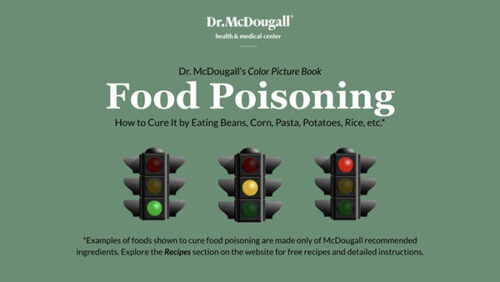The McDougall Diet: Defending the McDougall Diet If I Must
Headlines are made worldwide when a study is published that suggests people can continue to indulge in lobster drawn in butter, bloody-raw tri-tip beefsteaks, and crispy fried cheese. How can a single study be so convincing? The answer is simple: People love to hear good news about their bad habits. Now I don’t have to eat more vegetables.
Those of us who follow a healthy diet and have experienced the benefits know the truth. What is disturbing to me, and must be to you, is how intelligent researchers can come to conclusions so contrary to ours. Money is at the root of many of these studies, but often there is no apparent financial conflict of interest. The dinner table is a common source of confusion. Even the most honest scientific researchers are befuddled when in their right hand they hold a forkful of bacon and eggs and in their left hand they hold a study saying heart disease is caused by eating foods high in cholesterol and fat. Subconsciously, their right to gluttonous eating is defended at all costs—even in the design and interpretation of their research. From experience, most of us know how threatened people become over a vegetarian (vegan) diet.
So how do I really feel about research appearing as national headlines that contradicts my beliefs and findings? I love it! Finally, these subjects are being discussed. Throughout my career, my enemy has been being ignored. I have been silenced by shunning. Now, attention given to these matters of human nutrition will bring the facts to light and they can be debated. Eventually, the truth will be known and commonly practiced.
In the past few weeks three headline-grabbers have gained worldwide attention. Each one deserves consideration, but their overall findings do not change the bulk of the scientific research, common sense, and what I have taught for the past four decades. Allow me to explain these studies and give you my viewpoint.
Vegans Have More Fractures
Comparative fracture risk in vegetarians and nonvegetarians in EPIC-Oxford by Paul N Appleby published in the European Journal of Clinical Nutrition found a 30% increased risk of fractures in vegans compared to people following other diets and concluded, ‘In this population, fracture risk was similar for meat eaters, fish eaters and vegetarians. The higher fracture risk in the vegans appeared to be a consequence of their considerably lower mean calcium intake.’
Meat eaters were the fattest (the highest mean BMI) and tended to be the least active group, with vegans having the lowest mean BMI and reported the highest levels of walking, cycling and vigorous exercise. The causes of the fractures for all groups were falls, traffic accidents, other accidents, and unspecified or multiple causes. More than 70% of the fractures were caused by a fall. The most common fracture sites were wrist/arm and ankle. Current use of hormones (HRT) was highest in the female meat eaters. The difference in age between the meat eaters and vegans was nearly 11 years, with the vegans younger.
For vegan subjects who consumed at least 525 mg/day calcium, there was no increase in fractures rates. As a result, the authors suggested vegans should consume for extra calcium more almonds, sesame seeds, tahini (sesame paste), calcium-set tofu, calcium-fortified drinks and low-oxalate leafy green vegetables, such as kale.
Additional Information directly from the authors:
I communicated with one of the lead authors, Tim Key, about this well-publicized study.
Dear Dr. McDougall,
Thank you for your e-mail and interest in our recent paper. Paul (Appleby) and I have just discussed your questions. As you point out, the optimal intake of calcium for preventing fractures has been controversial and the evidence is somewhat conflicting. In our data, the only nutrient clearly associated with fracture risk is calcium, with a high risk among people with an intake below the UK EAR of 525 mg/d. In the current paper, the vegans eating at least 525 mg/d of calcium did not have an increase in fracture risk (risk ratio 1.00). The calcium comes from a range of foods and it is hard to single out any particular foods as the major sources for vegans (in contrast to non-vegans where dairy products are the major source). We don’t think that our results should be taken as an argument to eat dairy products; simply that vegans do need to eat enough calcium. Would you agree with the UK EAR of 525 mg/d as a reasonable minimum?
With best wishes, Tim Key
In another communication, Mr. Key felt his research methods accounted for the differences in age, HRT use, and activity. He wrote, ‘The fact that we saw no increase in fracture risk in vegans with calcium of at least 525 suggests that this is likely to be the explanation for the overall findings. For physical activity the measurements are not as good, and vegans did report more activity which increases the risk for accidents, but we have adjusted for this as well as we can.’
I asked Mr. Key, ‘In general, how do you explain your findings in face of world population data showing populations worldwide with the lowest calcium intakes have the fewest fractures – and the exact opposite results for protein?’ His answer was, ‘As you know this is complex and controversial. The ecological comparisons need to consider other factors too, like vitamin D, height, weight, environment, completeness of statistics, and weight-bearing physical activity.’
Comments:
The reason I believe this study found more fractures in the vegan group is these healthier, younger people were far more active and as a result sustained more injuries. Their increased physical activity leading to more fractures is noted by the fact that they were on average 11 years younger, were less fat (lower BMI), and were reported to walk, cycle and do other vigorous activities more than the meat, fish, and dairy groups.
The most serious kind of fracture caused by weak bones (osteoporosis) is a broken hip. In this study the vegans had no hip fractures, compared to 30 in the meat eaters, 9 in the fish eaters, and 14 in the vegetarians (dairy). The observation that the fractures were of the wrist, arm, and ankle, and not the hip, to me, means the fractures were due to trauma caused by physical activity and not due to weakened bones.
The average intake of calcium for the vegans was 603 mg/day for men and 586 mg/day for women—these levels exceeded those intakes of populations where osteoporosis is rare to unknown—like in rural Asian and African populations where intakes are commonly 400 to 500 mg daily. Since the vegans frequently participated in outdoor activities it is highly unlikely they had any deficiency of vitamin D—made from sunlight.
The conclusion of this study that the lack of calcium was the reason for the increased fractures in the vegans is in direct conflict with the bulk of the scientific research. For example, results of two excellent studies reported in 2006 in leading medical journals found no reduction in fractures following the use of large doses of calcium supplements.
In contrast to these studies, and most others, on the lack of influence of calcium intake on fracture risk, the authors of this study conclude calcium is the problem and this is based on findings in only 74 people with fractures following a vegan diet. You should be asking, how could such meager and contradictory evidence be so influential? Answer: People love to hear good news about their bad habits.
1) Appleby P, Roddam A, Allen N, Key T. Comparative fracture risk in vegetarians and nonvegetarians in EPIC-Oxford. Eur J Clin Nutr. 2007 Feb 7; [Epub ahead of print]
2) Abelow B. Cross-cultural association between dietary animal protein and hip fracture: a hypothesis. Calcific Tissue Int 50:14-8, 1992.
3) Frassetto LA. Worldwide incidence of hip fracture in elderly women: relation to consumption of animal and vegetable foods. J Gerontol A Biol Sci Med Sci. 2000 Oct;55(10):M585-92.
4) Lanou AJ. Bone health in children. BMJ. 2006 Oct 14;333(7572):763-4.
5) Wactawski-Wende J, Kotchen JM, Anderson GL, Assaf AR, Brunner RL, O’Sullivan MJ, Margolis KL, et al. Calcium plus vitamin D supplementation and the risk of fractures. N Engl J Med. 2006 Feb 16;354(7):669-83.
6) Prince RL, Devine A, Dhaliwal SS, Dick IM. Effects of calcium supplementation on clinical fracture and bone structure: results of a 5-year, double-blind, placebo-controlled trial in elderly women. Arch Intern Med. 2006 Apr 24;166(8):869-75.
Atkins Is Better Than Ornish, Stanford Study Says
Comparison of the Atkins, Zone, Ornish, and LEARN diets for change in weight and related risk factors among overweight premenopausal women: the A TO Z* Weight Loss Study: a randomized trial by Christopher Gardner in the March 7, 2007 issue of the Journal of the American Medical Association found, ‘In this study, premenopausal overweight and obese women assigned to follow the Atkins diet, which had the lowest carbohydrate intake, lost more weight and experienced more favorable overall metabolic effects at 12 months than women assigned to follow the Zone, Ornish, or LEARN diets. While questions remain about long-term effects and mechanisms, a low-carbohydrate, high-protein, high-fat diet may be considered a feasible alternative recommendation for weight loss.’
*The ‘A to Z’ stands for the four diets investigated: Atkins, Traditional (LEARN), Ornish, and Zone.
This twelve-month randomized trial was conducted in the United States from February 2003 to October 2005 among 311 free-living, overweight or obese, nondiabetic, premenopausal women, who were divided into four equal groups. Participants were recruited from the community by media (like the newspaper) advertisements. They were given one of four books: Dr. Atkins’ Diet Revolution, Enter the Zone, The LEARN Manual for Weight Management, Eat More, Weigh Less. Each group attended a one hour weekly class headed by a dietitian for eight weeks. The Zone and the LEARN diets had specific goals for calorie restriction, while the Atkins and Ornish groups had no specific energy restriction goals. The weight losses after one year were Atkins 10.3 pounds (-4.7 kg), Zone 3.5 pounds (-1.6 kg), LEARN 5.7 pounds (-2.6 kg), and Ornish 4.8 pounds (-2.2 kg). For me, a 3 to 10 pound weight loss for overweight and obese women after a year of dieting is not very impressive.
Comments:
Twenty-four years ago, when I started windsurfing, 500,000 more people worldwide were sailors than there are today. Why is the popularity of this sport falling when it provides an unsurpassed adrenaline rush of traveling 32 miles per hour across the water’s surface while standing on a two-inch thick foam board? The answer is: the learning curve is huge. I remember how it took me six agonizing days before I got my first ride. Once past the difficulty of learning days, windsurfing has meant 24 years of fun and great exercise for me.
Whether or not someone follows a diet depends upon how easy it is to learn. The Atkins Diet is the easiest to follow—you simply drive by a fast food window, order a burger, throw away the bun, and scrape off the pickles and ketchup, and you’re on the diet. The Ornish (like the McDougall Diet) is much harder to learn. The foods are unfamiliar. They can take time and effort to prepare. The social stigma associated with being a vegetarian is daunting. With such a steep learning curve few people succeed. This conclusion is substantiated by the observation that at 12 months the group on the Ornish diet (a diet of 10% of the calories as fat) was actually consuming 29.8% fat.
So what this study really means is changing eating habits is difficult and the majority of people are unwilling or unable to make meaningful dietary changes for any length of time. We need no more studies like this one to remind us of the fact that ‘diets fail’ for most people—but not for everyone. How about for those people who have gotten past the learning phase and adopted a diet for a lifetime? I, for example, have discovered that a healthy plant-food based diet is the most delicious and the healthiest way to eat (kind of like windsurfing is a really fun exercise).
Studies of successful dieters needed
What we now need are studies that look at the long-term results for people who do follow various diets. (It may be difficult to find people who follow low carbohydrate diets long-term. Atkins, himself, could not follow his own recommendations—when he died he was reported to be obese with heart and artery disease.)
The first place food affects the body is the bowels. Future investigations need to report the results of the effects of a McDougall-Ornish type diet and the Atkins Diet on bowel movements. In his own research Robert Atkins reported 70% of people following his diet are constipated. Anyone following the McDougall Diet knows the effects on bowel movements (often 3 times daily, easy to pass, and large).
Next investigators should look at calcium balance and see what happens to the bones on these high-protein, high-acid diets, like Atkins, the Zone, and South Beach. As a first phase, this can be simply done by measuring the amount of calcium excreted in the urine over 24 hours. Research consistently shows that a decrease in animal protein decreases loss of calcium from the bones into the urine. Next biochemical markers of bone turnover can be measured in the urine. These reflect the rate at which bone material is being lost. High protein diets have been shown to increase bone turnover based on these markers.
Decreases in blood sugar, cholesterol, and triglycerides have been found with the Atkins Diet, but these changes are a result of suppression of appetite, followed by semi-starvation, which are the underlying mechanisms of this ketogenic diet. Similar blood chemistry results can be accomplished by giving patients cancer chemotherapy, which causes them to lose their appetite and starve—the same as the Atkins Diet.
Rather than checking risk factors, like cholesterol and triglycerides, more direct measurements of the effect of diet on the heart and blood vessels needs to be made. For example, a relevant measure would be the compliance of the artery walls, which is determined by ultrasound measurements over the ascending aorta (the large artery leading from the heart) and the right carotid artery (neck). Previous results show a 27% decrease in arterial compliance after a single meal consisting of 67% of the calories as fat. Immediate effects of a single high-fat meal can be seen by a visual examination of the eye (conjunctival capillaries) and the oxygen content of the arterial blood. Research has shown that a diet high in fat (67% of the calories) fed to people causes the circulation in the eye to visually sludge, along with a decrease in the oxygen content of the blood by 20%.
Long-term effects on the heart arteries would require months and years to assess. Reversal of atherosclerosis has been demonstrated by angiograms and PET scans after following the Ornish Diet for 12 months and longer. The only study of patients on the Atkins Diet has shown a worsening of blood flow at one year from all that saturated fat and cholesterol with an overall cumulative progression of artery disease (atherosclerosis) of 39.7%.
I believe the trend has shifted away from the popularity of high-protein diets of the 90s and the first half of this decade. People have tried to lose weight eating all meat and cheese—they felt sick and were constipated, and their weight loss was temporary and trivial. In addition, we are learning that one of the planet’s greatest sources of pollution is livestock—so even if these high animal-food diets were good for humans—and they are not—they are undeniably killing our planet.
1) Christopher D. Gardner; Alexandre Kiaz
/misc/2007nl/jun/vegan.htm”
Recommended Articles

Dr. McDougall’s Color Picture Book: "Food Poisoning"

Vitamin D: Values for Normal Are Exaggerated





